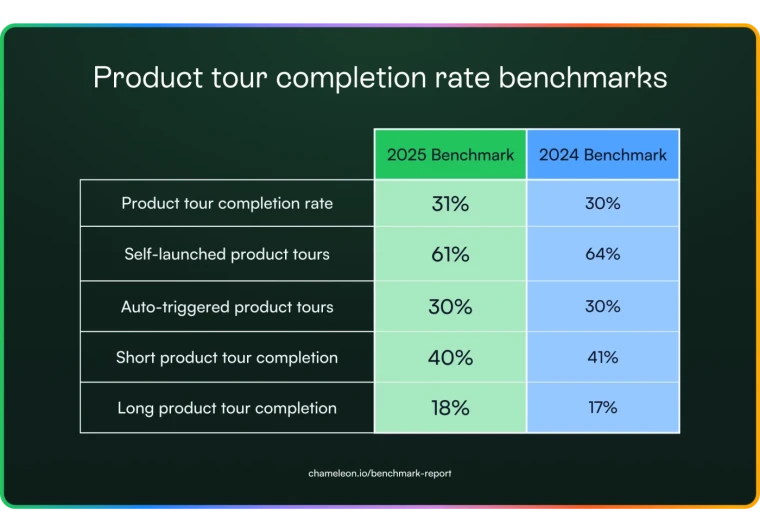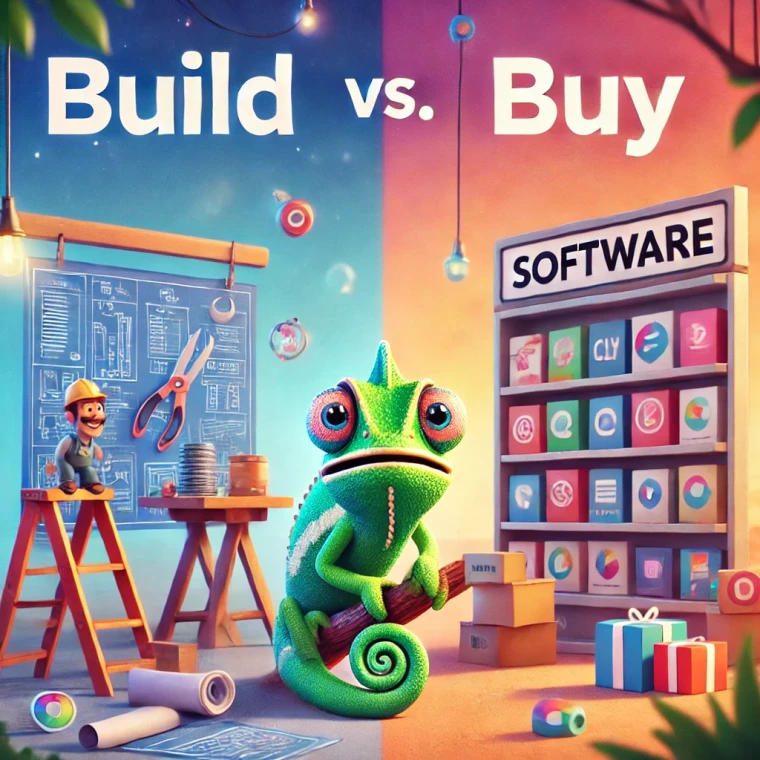Onboarding emails aren’t just messages. They’re the first chapter in your product’s story and an opportunity to guide users to the pivotal moment when your product's value dawns on them—otherwise known as "Aha!" moments.
Here's the issue: writing onboarding emails that stand out from the noise isn’t easy. If you don’t capture attention and deliver real value, your emails might just end up in the dreaded folder that shall not be named. 🚮
In this article, we’re diving into some of the best onboarding email examples to show you how to hook your users from the first click.
We also cover best practices, strategies, and channels you can use for smooth email onboarding experiences.
Let’s get into it!
Onboarding emails help new users explore your product and reach key milestones. They boost engagement, reduce churn, and guide users to their "Aha!" moments.
To nail your onboarding emails, set clear goals, highlight your value, motivate with rewards, personalize content, and send behavior-triggered messages.
Use a mix of emails, in-app messaging, and product tours for smoother onboarding.
What are onboarding emails?
Onboarding emails are messages designed to guide new users through your product, helping them unlock its value, like setting up their account or completing their first task. They’re your way of leading users to those “Aha!” moments, where they see how your product solves their problem or makes their life easier.
To do onboarding right, you need to reach your audience using the right channels, email being one of the most efficient, because:
It's ubiquitous; as the one platform accessible and standardized for all your users
It's understood and expected; users require low effort to engage with it
It's accessible; SaaS tools make creating and delivering emails easy
Be warned: Since email is so universal and easy to use, users are flooded with them. If yours don’t stand out, they’ll just get lost at sea.
That's why it’s crucial to craft onboarding emails that don’t feel like every other email in the inbox. If they’re dull and formulaic, people will assume your product is the same. But if they’re engaging, helpful, and thoughtful, you’re setting the stage for a great user experience. But why does this matter?
Why are onboarding emails so important?
Onboarding emails are your product’s first real handshake with a new user. Done right, they set the tone for the entire relationship.
A strong onboarding sequence builds trust, boosts product adoption, and keeps users engaged. It’s your way of showing new users they’ve made the right choice.
Onboarding emails matter because they:
Guide users through key product features
Increase product adoption and reduce churn
Build trust and a lasting connection with new users
Improve customer retention by creating a seamless experience
Help users reach those all-important "Aha!" moments faster
Onboarding emails are your chance to make a lasting impression. Nail this step, and you're already halfway to creating loyal, happy customers. Scroll to see how other companies engage their audiences using emails.
10 Best onboarding email examples 📧
A great onboarding email sets the tone, sparks curiosity, and keeps users coming back for more. Let’s dive into 10 examples of onboarding emails that go beyond the basics.
1. Welcome email 👋
Proper onboarding welcome emails set the tone for your entire relationship with a user. It’s that first hello where you make your product feel approachable and human. Once you greet your customer, it's time to highlight your product's key benefits.
Read’s onboarding welcome email is concise and takes no time to introduce the product and set up its users for their first use.
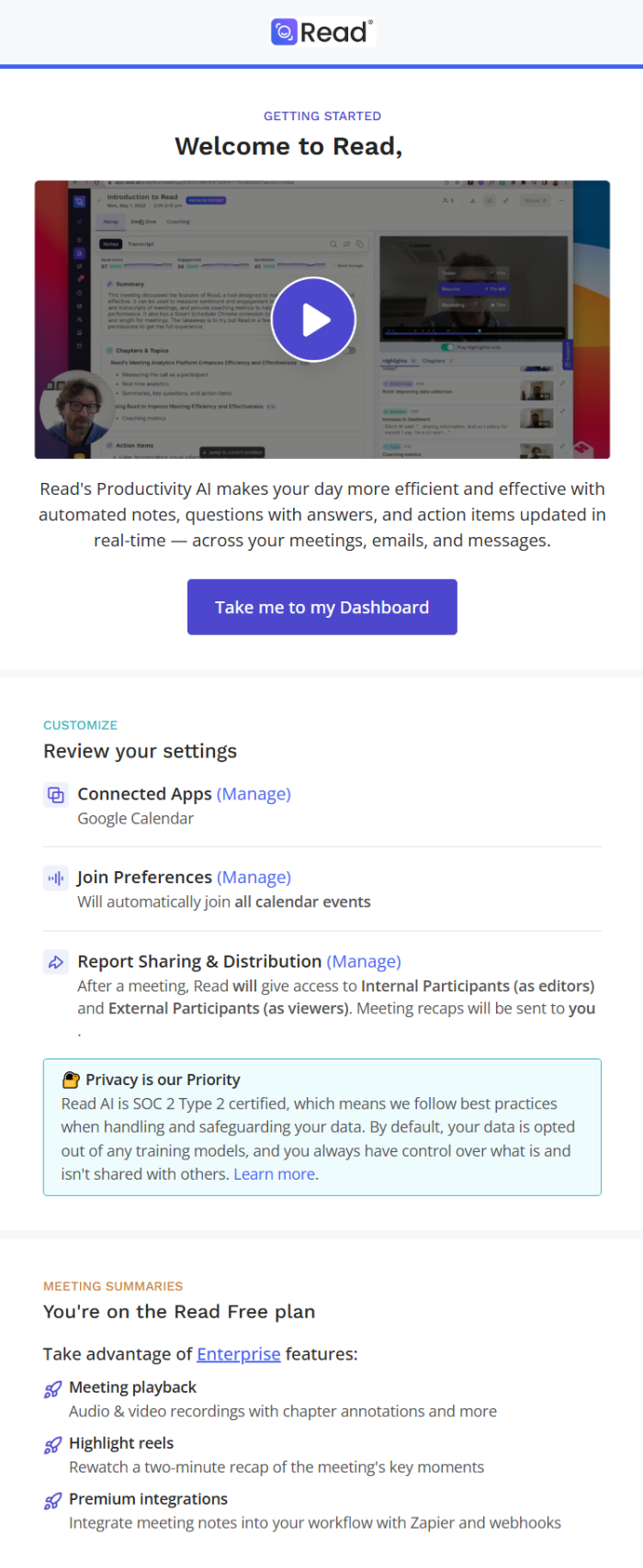
2. Explainer email 📈
Explainer emails dive deeper into your product's features. They're your chance to show users what your product can do.
While you can get into the nitty-gritty here, don’t get too verbose. Keep your explanation simple, highlight core benefits, and guide users to key actions that demonstrate value, as Hemingway Editor does in the example below.
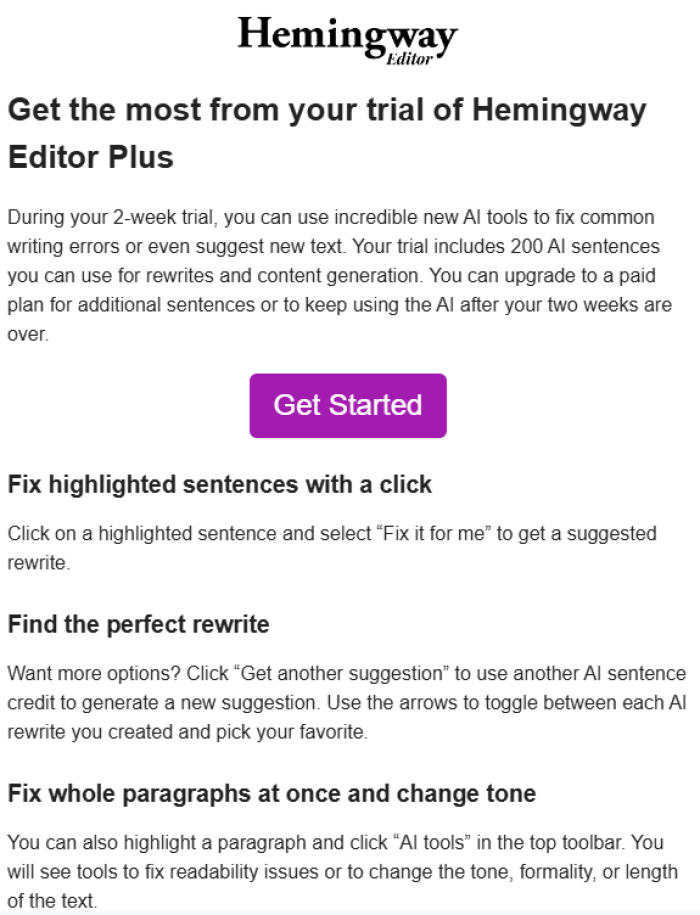
Once users are familiar with your product’s basics, a "Next Steps" email is perfect for nudging them toward the next big milestone.
Whether it’s setting up their profile, testing a feature, or unlocking a new capability, this email is all about keeping users on the path to success. Look how Ahrefs guides users into taking their very first steps toward successful projects (AKA product adoption).
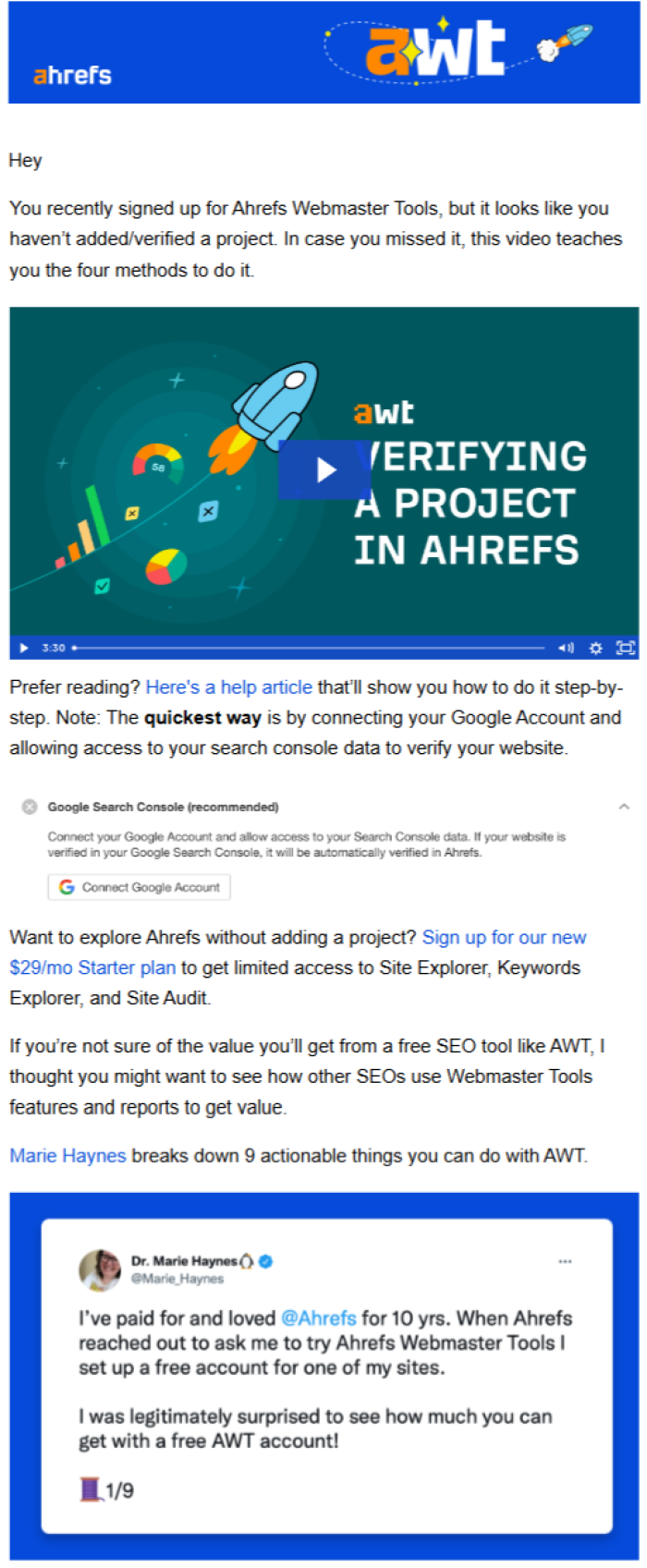
4. Community building email 🤝
Nothing brings users closer to a product than a sense of belonging. A community-building email invites users to join the larger conversation—whether it’s through forums, social media groups, or exclusive webinars.
These emails aren’t just informative; they’re about building connections and turning users into active participants in your brand’s community.
Surfer SEO gets it! Their team set up a community-focused webinar and invited their users to join the conversation.
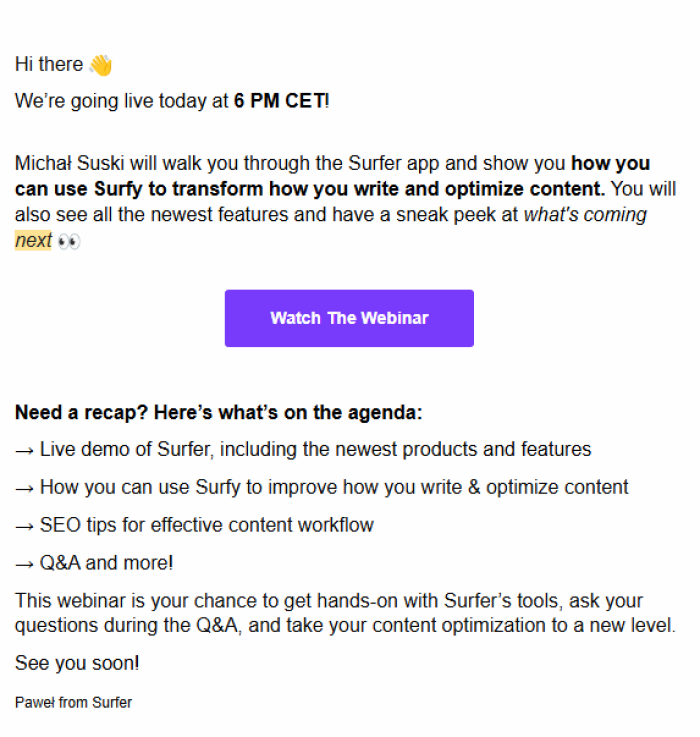
5. Upselling email 💳
The upselling email is your product’s smooth salesperson, gently nudging users toward premium features or upgraded plans.
This isn’t a hard sell. The key is to frame the upsell to clearly show how the upgrade enhances user experience or addresses an unmet need.
Let’s take a look at a great example from WordPress hosting:
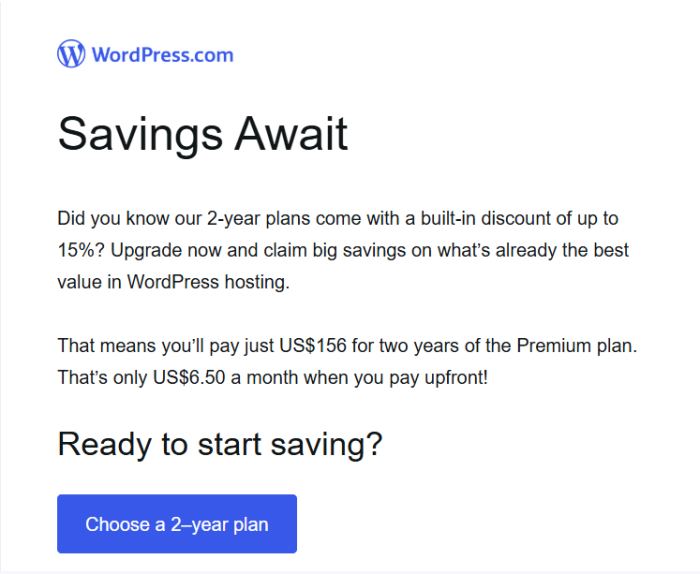
This email works because it highlights immediate savings, up to 15% off, making the upgrade feel like a smart, cost-effective choice. The pricing is clear and easy to digest, showing users exactly what they’ll pay and how affordable it is.
6. Gamification email 🎮
Gamification emails add a playful twist to onboarding. They challenge users to explore more of your product through fun incentives like badges, progress bars, or mini-challenges.
The endgame? Make learning your product feel less like work and more like fun. When done right, these emails can skyrocket engagement by tapping into users' natural drive to compete and achieve. Pair of Thieves made theirs a maze.
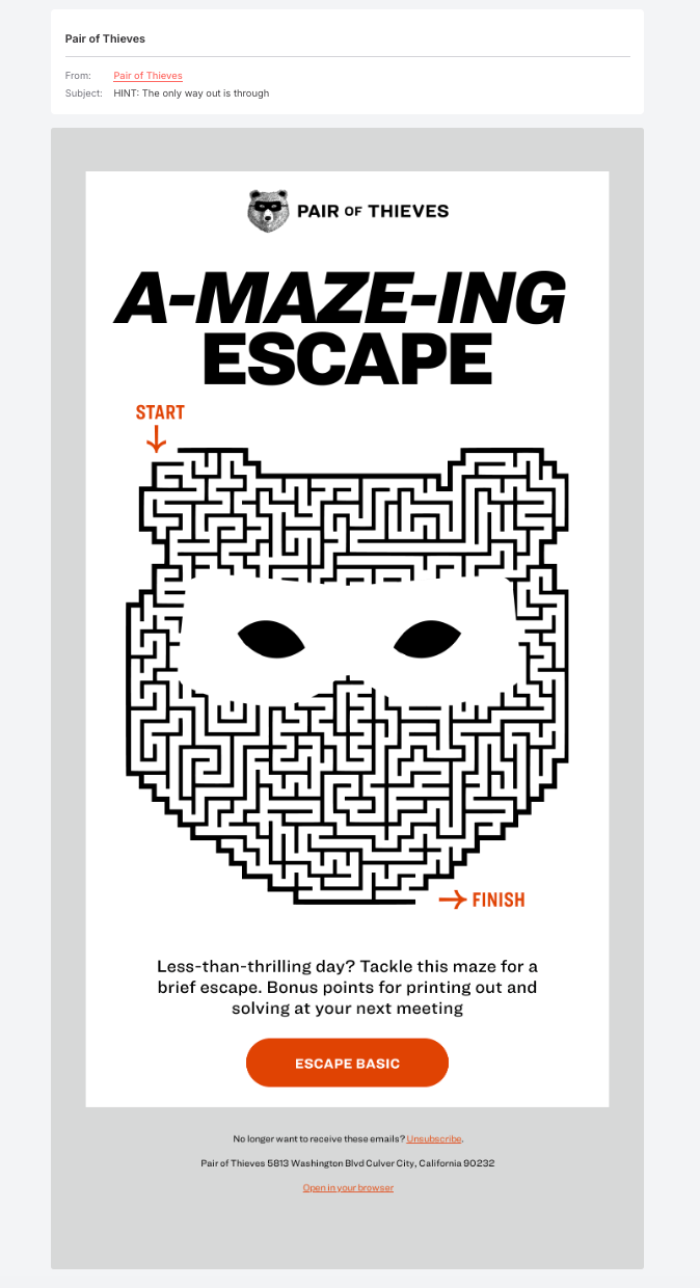
(Source)
7. Rewards and encouragement email 🏅
Everyone loves a little recognition! A rewards email celebrates your progress as a user, whether you’ve completed a key task or hit an important milestone. It’s a simple yet powerful way to keep users motivated and eager to explore more.
Plus, when users feel rewarded, they’re more likely to stick around and continue engaging with your product.
DuoLingo’s reward emails never fail to encourage us to return to learning. 🧑🎓
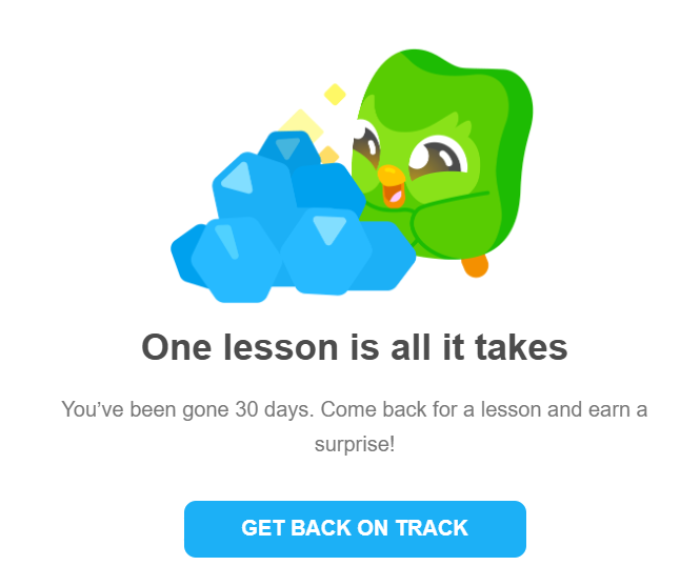
8. Interactive email ▶️
Interactive emails are the perfect way to boost engagement while educating users. Whether it's a quiz, video, or clickable walkthrough, this type of email invites users to actively participate rather than passively read. The best part? Interactive elements make learning about your product feel natural and enjoyable. To engage readers, Mailmodo went for a survey.
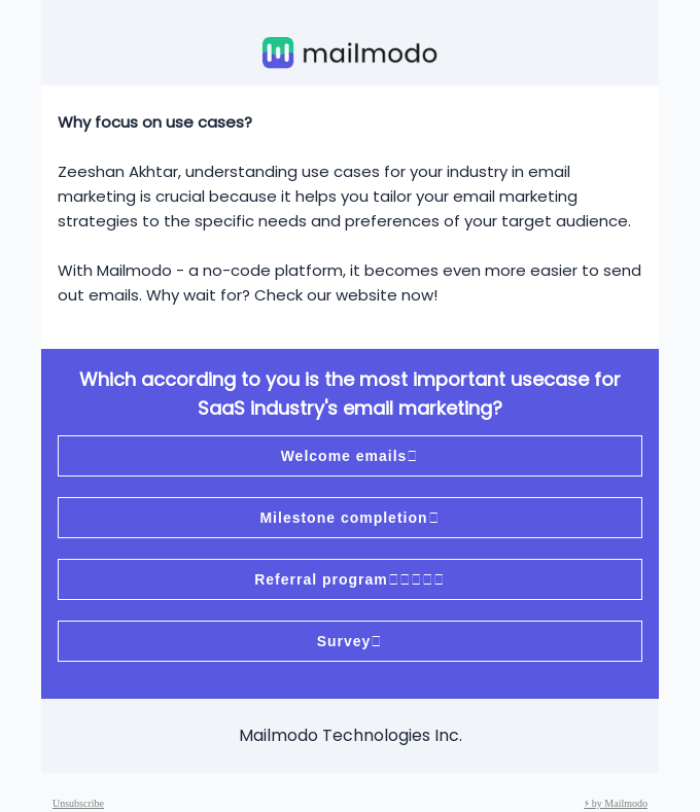
(Source)
9. Help emails 🆘
Sometimes, users just need a little extra help using your product. A well-timed help email is like a friendly guide that swoops in when things get tricky.
It offers resources like FAQs, tutorials, or direct support options, showing users they’re never on their own. These emails are perfect for easing frustrations and ensuring users feel supported at every step. In the example below, Leadfeeder went for a step-by-step tutorial on how to set up a project.
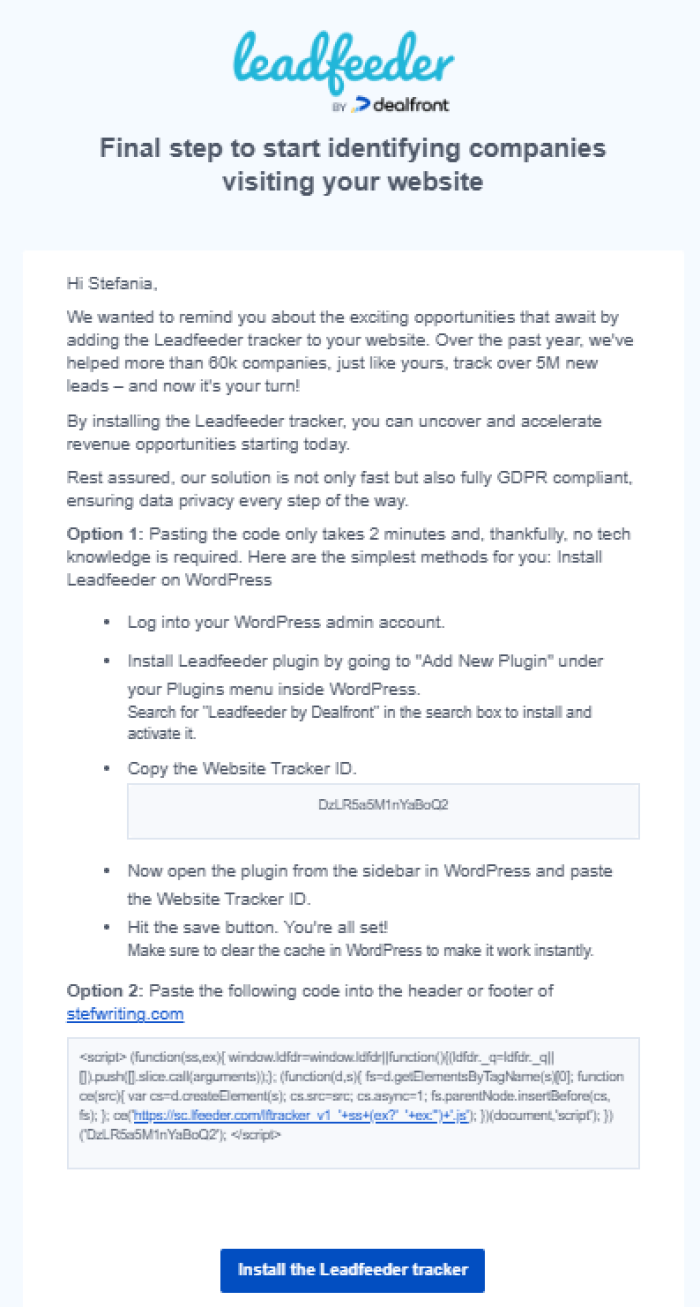
10. Feature update email 📲
Feature update emails keep users in the loop about exciting new product additions. Whether it’s a small tweak or a game-changing feature, these emails help build anticipation and encourage users to try their hand at the new. The key is to make the updates feel relevant and exciting, turning them into opportunities for further engagement, like Notion does in the email below.
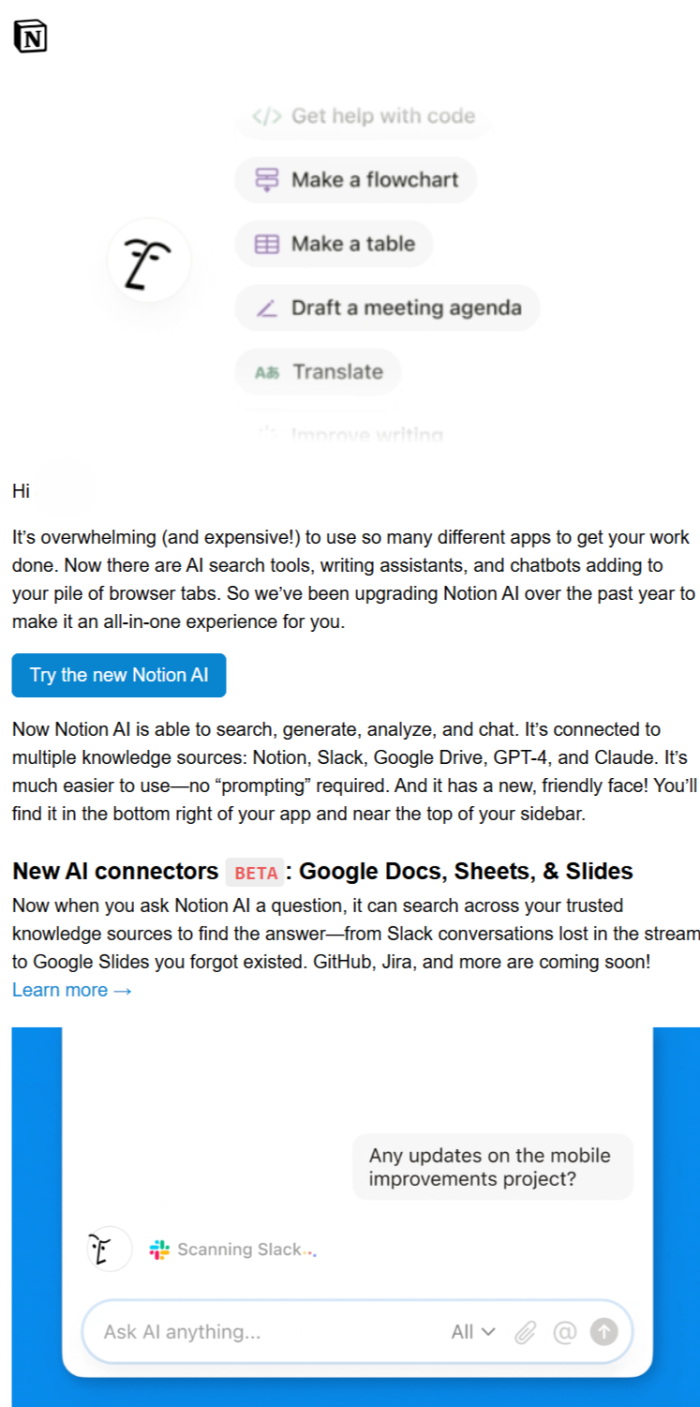
Curious to see more inspiring emails?
Sign up for the Chameleon newsletter and get the best examples straight to your inbox!
5 best practices for writing captivating onboarding emails
With all these examples, we bet you're inspired. But don't start writing your onboarding email just yet. Review these tried and true best practices first to ensure your onboarding email sequence is a hit.
1. Get clear on your objective before writing your onboarding email
Before you start writing your onboarding emails, get clear on your goal for the user onboarding phase. What do you want users to achieve?
Start by identifying your product’s "Aha" moments. Then, figure out what obstacles might prevent users from reaching those moments.
Your emails should focus on motivating users by explaining why they should take action, not just how to do it. This approach will help keep users engaged and moving through the onboarding process.
Chameleon Tip: Each user has different challenges that can stop them from reaching their Aha moment, so your product might need multiple onboarding paths based on user behavior. We recommend starting with one simple path and adding more steps as you go.
2. Reinstate your value proposition
Users will get to the Aha moment more quickly if they know WHY they should use your product. This means that user onboarding emails should focus on the problems and solutions, and not just on the features.
You can reference both the benefits of using your product and also the risks of not using it. To find the most important benefits, talk to current customers, gather their feedback, and identify the specific pain points your product solves for them. This insight will help you create emails that resonate with new users and motivate them to take action.
🦎Tip: Tailor the value proposition in your onboarding emails to the specific user persona needs or job-to-be-done. Each persona or job will have a different use case and outcome.
3. Motivate readers using the Hook model
Motivation is key to driving users toward success, and a simple way to boost it is through positive reinforcement. Our brains crave rewards, and dopamine—the "feel-good" chemical—gives us the energy to keep going.
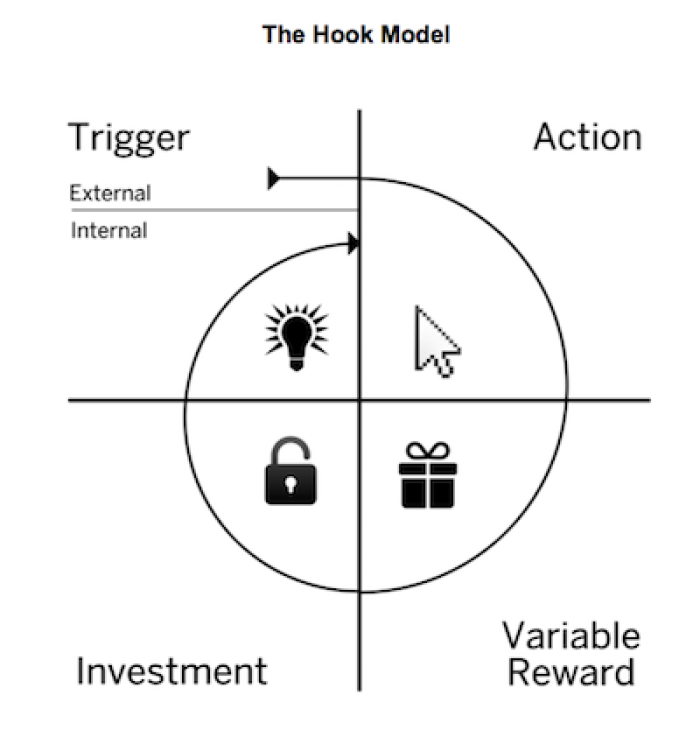
Nir Eyal’s Hook Model explains that rewarding users after they complete an action, before asking them to invest more, helps build habits. Congratulate users when they hit a milestone and nudge them toward the next step. This deepens engagement and keeps them moving forward in your product.
🦎Tip: Congratulate users when they successfully reach their goals and encourage them to take the next step to discover further value and deepen their engagement with your product.
4. Write behavior-triggered emails
Not all user journeys are the same. Some users sign up and then get distracted, while others explore your site but don’t convert right away.
By sending behavior-triggered emails that align with each user’s progress (like a welcome email on signup), you keep their attention without overwhelming them with irrelevant info. Each email helps move users closer to key actions without repeating steps they’ve already taken.
5. Personalize your emails
Personalizing your onboarding emails is all about making users feel like VIPs. It’s more than just using their name—it’s showing you’re paying attention to their journey. Mention what they’ve done, what they’re struggling with, and what might help them next.
Adjust your messaging based on their experience level, whether they're just starting or diving deep. Tailored emails keep users engaged and moving forward, making them feel understood and valued. That’s the key to building a lasting relationship.
🦎Tip: Be sure to identify and measure the friction points preventing users from reaching these goals, so you can tackle these as part of your user onboarding emails. If possible, make the emails contextual and personalized.
But even if you nail your onboarding emails, they’re just one piece of the puzzle.
You could have the best welcome email, the clearest instructions, and the most motivating content—but if that’s all you’re relying on, you’re only scratching the surface.
You need emails AND in-app messaging for successful onboarding
Onboarding is a bit like cooking the perfect meal: it’s about blending different ingredients to get the right blend of flavors. If you're leaning solely on emails, you're missing out. A combo of emails, in-app messaging, and product tours will keep your users hooked. Here’s why:
Email: Great for delivering key details—think signups, confirmations, and deeper content that keeps users coming back. But don’t get carried away! Users face inboxes full of useless emails daily, so make sure yours are spot-on.
In-App Messaging: Your users are already in your product, so hit them with the right message at the right time. But here’s the catch: if they haven’t engaged yet, they won’t see your message.
Product Tours: Interactive, fun, and informative. They guide users through your product, but be careful—bad tours can feel like a tedious walk through a maze.
The trick? Using tools like:
Intercom: Think of it as your direct line to users—delivering personalized, in-app messages and emails just when they need them most. It keeps your communication timely and engaging.
MailChimp: Your email campaign powerhouse. With its smart automation and audience segmentation, you can send perfectly timed onboarding emails that hit the right inbox at the right moment.
Chameleon: The in-app tour guide that takes users by the hand, leading them through your product step-by-step. It makes onboarding interactive, intuitive, and contextual.
Tools like these help you make each channel shine and work together. When done right, these three will keep users engaged and lead them through a seamless onboarding journey.
Use onboarding emails as tickets to a smooth user journey
Onboarding isn’t a one-size-fits-all process, and it’s definitely not just about firing off a few emails. It’s about creating a smooth, cohesive user journey across different touchpoints—emails, in-app messages, and product tours.
Each channel has its strengths, and when used together, they can turn curious signups into loyal, engaged users. So, don’t stop at just writing great emails—blend them with the right in-app nudges and interactive tours to create an onboarding experience that feels seamless, intuitive, and, most importantly, memorable.
Now, it's time to craft that perfect mix and get your users excited to dive deeper into your product!

